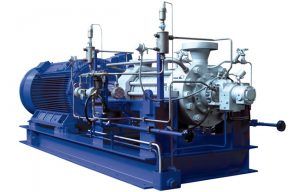Preventive maintenance of pump bearings

Preventative maintenance techniques are employed to ensure that a pump bearing is operating properly. This is accomplished by examining changes in noise, vibration, temperature, and lubrication. These characteristics are dependent on the application conditions, including speed, loading, lubrication, and environment. Detecting a change from the baseline conditions will indicate possible deterioration of the bearing and suggest an immediate maintenance action.
Following are excerpts from a paper, "Bearing Maintenance Practices to Ensure Maximum Life" By Miles Woodard, application engineer, and Mark Wolka, product engineer at NSK Corporation at the 2011 Pump Users Symposium held in Houston, Texas.
Noise is audible sound heard by equipment technicians. It is important to be able to distinguish normal sounds from the pump system during operation and abnormal sounds when the system is not operating correctly. Typical causes of bearing noise are insufficient operating clearance, excessive clearance, damaged contact areas, contamination, and unsuitable lubricant.
Many common problems in machines, such as imbalance, play, misalignment, can best be evaluated by measuring vibration displacement or velocity. Vibration is measured using accelerometers mounted on the equipment. There are standards for evaluating machine performance based on vibration.
The vibration of rolling bearings can be evaluated in several ways. In cases where vibration data is recorded and the vibration of each new mounted bearing is known, then the vibration acceleration should be compared with the original level to evaluate performance. As a bearing wears or becomes damaged, the magnitude of vibration will increase.
It is possible to attribute certain vibration frequencies to damage on specific bearing components. Software tools are available that can analyze vibration or a sound recording and compare it to known bearing frequencies to aid in fault determination.
Bearing temperatures can be estimated from housing temperatures, oil sump temperature, or oil circulation system outlet temperatures. However, using thermocouples to measure the bearing outer ring temperature directly is more accurate. Temperature rise in bearings is a result of friction. Deviation from the steady state temperature can be caused by lubrication starvation, excessive lubrication, incorrect lubricant, contamination, preloading, abnormal loading, coupling misalignment or bearing failure.
Maintaining the proper amount of oil or fresh grease is vital to bearing life. Oil sumps should have a sight glass to help maintain the level of the oil to the center of the bearing’s bottom rolling element. Oil circulation or oil mist systems should supply oil at the correct rate to provide an adequate oil film layer and control bearing cooling.
Housings for greased bearings should have space for old grease to exit. Equally as important to the amount of lubricant is the quality of the lubricant. Oil sampling is a popular method to periodically check the machine’s lubrication for impurities and foreign particles. High chrome (from bearing rings) or copper (from brass cages) concentrations indicate possible bearing wear. Sample analysis can also indicate water content and the degree of oil deterioration. Similarly, purged grease after regreasing can be analyzed for contamination, oxidation, degradation of additives, ageing, or moisture content.
The procedure for removing and inspecting a bearing will be similar for regular preventative maintenance as it is for addressing a bearing issue. The following are recommended steps to perform:
- Collect and evaluate any data from bearing monitoring devices.
- Before disassembling the bearing housing, measure the axial movement of the shaft. Take lubrication samples for analysis.
- Look for water intrusion or grease leakage in the bearing housing as a sign of seal failure.
- Check other areas of the bearing housing for damage.
- Examine the bearing condition as mounted. Mark the bearing to indicate mounted positioning.
- Remove the bearings from the housing or shaft. Use care to remove properly. Note any marks created during dismounting so that this damage is not confused with damage created during operation.
- Check the bearing seats and contact surfaces on the shaft and housing.
- Inspect bearing
- Important evidence of a failure can be altered or destroyed if careless dismounting practices are used. Photographs of the inspection process can aid in process improvement or in the event that a bearing manufacturer supports the failure analysis.
When inspecting the bearing, check for the following:
- Cracks or chips on any component
- Measureable wear on the bearing bore and outer diameter
- Discoloration
- Noticeable wear or damage on the rolling elements or raceway surfaces
- Wear or damage to the cage
- Bent or damaged seals or shields
- Rust or corrosion on any component
If any of these conditions are present, the bearing should be replaced with a new one. In a case where the problem cannot be easily ascertained, it is a good idea to contact the bearing manufacturer. When sending a failed bearing to its manufacturer, there are three steps.
First, do not dismantle or clean the bearing. This will avoid damage from disassembly and keep lubrication evidence intact. Second, place the bearing by itself in heavy, sealable plastic bags to avoid contamination during shipping. Rags and paper wrap should be avoided because they can absorb oils and do not keep out moisture. Finally, use adequate packaging so that damage does not occur during transport.
In addition to the bearing, send any historical maintenance records of problems with the machine or bearing. Send any photographs from the bearing removal and inspection process. Send data from bearing monitoring devices. Lastly, send all known application data for the bearing in question. Application data includes speed, load, lubrication, shaft and housing fits, sealing, arrangement, and environmental conditions.